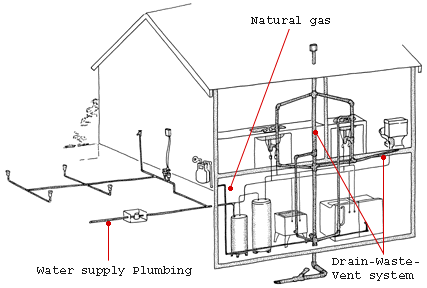Home > House Structure > Plumbing
Plumbing
Plumbing in houses refers to the system of pipes, fixtures, and fittings that enable the distribution of water, as well as the removal of wastewater, within a residential building. It plays a vital role in providing clean water for drinking, cooking, bathing, and other household activities, while also ensuring the safe disposal of wastewater to maintain hygiene and sanitation.
The plumbing system in a house typically consists of several key components:
I. Water Supply: The water supply system brings fresh water into the house from a public water main or a private well. It includes a water meter, shut-off valves, and pipes that distribute water to various fixtures.
II. Water Heater: The water heater heats water for domestic use, such as bathing and washing dishes. Common types include tankless water heaters, storage tank water heaters, or solar water heaters.
III. Fixtures: Fixtures are the points of water use in a house, including sinks, faucets, showers, toilets, bathtubs, and appliances like dishwashers and washing machines. These fixtures are connected to the water supply and wastewater drainage systems.
IV. Drainage System: The drainage system carries wastewater and sewage away from the house. It includes drain pipes, traps, and vent pipes that ensure proper drainage and prevent the escape of sewer gases.
V. Plumbing Vents: Plumbing vents allow air to enter the system, preventing suction or pressure issues and promoting proper drainage. Vents also help remove unpleasant odors from the plumbing system.
VI. Plumbing Fixtures and Fittings: These include pipes, valves, connectors, and other components used to transport water throughout the house. Common materials for plumbing pipes include copper, PVC (polyvinyl chloride), PEX (cross-linked polyethylene), and galvanized steel.
VII. Backflow Prevention: Backflow prevention devices prevent the contamination of the potable water supply by ensuring that water flows in one direction. These devices are installed at critical points to prevent the backflow of wastewater into the fresh water supply.
Plumbing in houses offers several benefits:
I. Access to Clean Water: Proper plumbing systems provide a reliable supply of clean, potable water for drinking, cooking, and other daily activities.
II. Convenience and Comfort: Plumbing systems allow for convenient access to water throughout the house, making tasks like bathing, cleaning, and laundry much easier and efficient.
III. Hygiene and Sanitation: Effective plumbing systems ensure the proper removal and disposal of wastewater, reducing the risk of waterborne diseases and maintaining a hygienic living environment.
IV. Increased Property Value: Well-maintained plumbing systems add value to a property, as they are essential for modern living and are sought after by potential homebuyers.
V. Water Conservation: Modern plumbing fixtures and technologies, such as low-flow toilets and water-efficient faucets, help conserve water and reduce utility bills.
It is important to note that proper installation, regular maintenance, and occasional repairs are necessary to ensure the efficiency and longevity of the plumbing system. Professional plumbers are often consulted for the installation, inspection, and repair of plumbing systems to ensure compliance with local building codes and standards.










